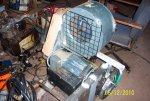you can't really affect the heat transfer rate within the windings themselves, which will still be air cooled.
Good call JF, came to the same conclusion myself !
Inspired by the air bearing audio noise thread, thought I'd throw this 5 to 10 HP 'project' out there just 'for fun'.
Did this 'conversion' a few years back, had a pump off a MTM 15 HP washer, but only had the 5 HP 184T motor in my 'junk' pile.
Photo is how I ended up cooling it - about 1000 CFM airflow, ducted THRU and around the motor.
I measured 48.7A at 240 Vac to the 184T motor when using a 40 deg pressure washer nozzle, have run it for over 4 hours straight and motor case only reaches 143F on a 70F day. I should have put a thermocouple inside the windings, but only put one on the outside. The fan pulls another few amps, but have never yet tripped the 50A breaker even though in excess of code guidelines. All wires in conduit, 6 AWG feeder.

1000 CFM about 70 # of air per minute, so say 15 BTU per deg F per minute if 100% effective heat transfer, or 900 BTU/hr per deg F
Motor likely only 80% efficient at 100% overload, so around 8000 BTU/hr heat loss.
Typically try to keep airflow differential of 15F or less in forced air cooling setups.
Air leaving at about 85F means 15*900 = 13,500 BTU/hr capability if 15F adhered to
73F rise means air leaving is 8000/900 = only about 9F temp rise in exhaust air, so the setup has cooling margin .
Interesting that the 48+Amps and 80% efficiency guess falls about right on 200% load level of an eyeball extrapolation of the Baldor curves that Ingenier posted.

